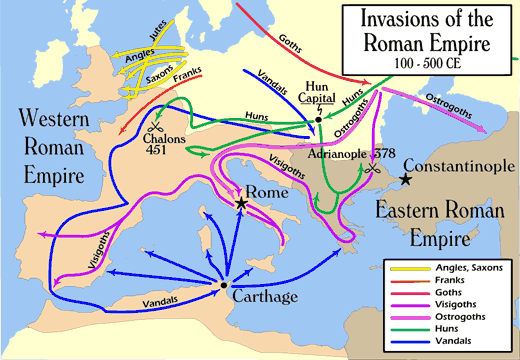The Huns were called “Xiongu” by the Chinese during the Han Dynasty and were probably of Turkish origin. Allegedly pushed out of the Chinese Empire, they (app. a hundred thousand people) separated into two groups. One went south and the other northwest, where the Goths had settled. The most famous is Attila, or the “Scourge of God,” who lead the Huns around 350 AD.
The Goths, an ancient Teutonic (germanic) tribe that migrated from the north across the Baltic Sea, reached the coast of Asia Minor in the 3rd century. In 267 they captured and plundered Athens and began an onslaught of attacks against the Roman Empire.
Around 370 they divided into two groups; the Ostrogoths in the east and the Visigoths in the northwest. The Visigoths, threatened by the advancing Huns, asked the Roman Empire for protection but the conditions in which they were forced to live caused a revolt. The Huns crossed the Danube to ally with the Visigoths and together they sacked Rome in 410. Theodosius I, Byzantine emperor of the Roman Empire in Constantinople, reached a peaceful arrangement with the Visigoths, where the Visigoth and Byzantine armies merged.
The Goth bishop Ulfilas translated the Bible into Gothic and converted many people to a Christian sect called Aryanism. Aryanism, named after its founder Arius, was labeled as a heresy by orthodox Christians, as Arians did not believe that Jesus was a divinity. Essentially Arius maintained that God was infinite and un-begotten whereas Jesus, the son, was begotten and therefore could not be divine.
The Vandals made their way south around the 5th century. They fought the Spaniards, the Gauls, the Visigoths, and the Romans but were ultimately defeated by Rome when they penetrated North Africa. In 435 the Vandals occupied Algeria and northern Morocco and signed a treaty with Rome. Four years later they plundered Carthage. In 477 they entered and plundered Rome. Their decline came when they were defeated by the Byzantine general Belsarius in 534.
Rome, already plagued with widespread political, economic and social troubles, could no longer sustain the repeated barbarian assaults. In 475 the Goths captured the city and the last Roman emperor, Romulus Agustulus, was deposed. The western world became a melting pot of different tribes, the major groups being the Francs, the Lombards, and the Saxons. Roughly, the Francs occupied Gaul, the Lombards occupied northern Italy, the Saxons occupied Briton and the Goths occupied Spain.
In the 6th century a northern tribe, the Burgundies, invaded France and established the kingdom of Bourgogne but they were defeated in 534 by the Merovingians who controlled the area. After the death of the Merovingian emperor Dagobert the Frankish kingdom was divided amongst the nobles, notably the Carolingians. Charles the Great (Charlemagne) extended the Carolingian dynasty and was crowned Holy Roman Emperor in the year 800. After his death his son, Louis I, became king of France.
The word “barbarian” comes from Greek to stammer, to identify a foreigner. Today we use the word to define the nomadic populations that migrated into Europe starting with the Germanic tribes.
Barbarian Invasions and Tribes
in Europe
3rd century - 6th century

Greece
Tribes from the
northeast migrating
south